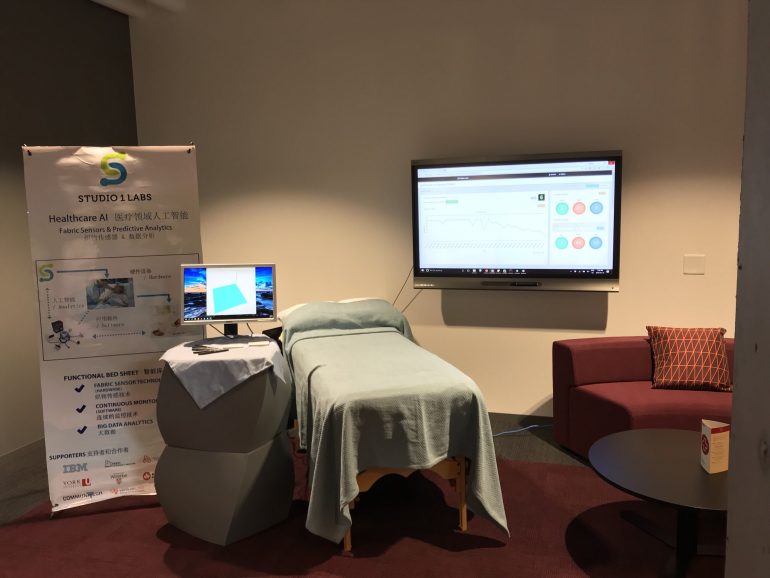As part of a regular series powered by IBM, BetaKit interviews Canadian tech leaders using innovation for the greater good.
They say that businesses are often built from a founder’s passions, and the story of Studio 1 Labs is no different. For some founders, however, that passion is to not only build a great business, but to do good in the world.
Studio 1 Labs has developed fabric sensors, using them in an intelligent bed sheet patient monitor for long-term care. Borne of its founders’ mission to offer low-cost, high-quality preventative care around the world, these fabric sensors send data to computers that use AI and machine learning algorithms to give doctors real-time information about a patient’s health and wellbeing.
The end goal is a clinically-tested medical device accepted in long-term care and healthcare institutions around the world.
Building the technology
After grad school, Studio 1 Labs co-founder Dr. Olivia Lin developed an interest in textiles and how they relate to human learning and behaviour, the topic of her PhD.
Studio 1 Labs’ algorithms alert doctors if something may go wrong.
Connecting with co-founder Edward Shim, an idea blossomed for a textile to help identify and track that behaviour. After a series of mentorship programs with organizations like IBM, the team built the intelligent bed sheet prototype.
The sheet has sensors built into the fabric, which measures respiration, movement, and other factors that may indicate health issues. The sheet is also connected to a machine learning-based algorithm that identifies precursor trends for doctors. With a particular focus on early detection of symptoms, Studio 1 Labs’ algorithms alert doctors if something may go wrong, leading to preventative measures.
A product-market pivot
Initially, the founding team thought the sheet would be perfect for babies. Given infant mortality rates in developing nations around the world, the ability to detect early warning signs such as respiratory distress could mean the difference between life and death. However, early user testing showed that many parents were wary.
“Some of the earliest user feedback was that parents don’t trust the fabric because they don’t know what it is,” explained Lin. “It’s not about learning a new technology… it’s about consumers feeling a technology is medically validated.”
On the medical side, new technologies cannot disrupt or harm currently existing technologies.
With user feedback showing that people feel safer using products with scientific or medical validation, the team went ahead in seeking clinical trials to ensure its technology would be an approved “medical device.” Unfortunately, Studio 1 Labs discovered that testing on babies is nearly impossible due to medical sensitivities and consent issues.
Facing the loss of its core target market, the team planned a pivot into the senior long-term care market. Senior patients, the team found, liked that they couldn’t notice the technology within the bed sheet.
“You can’t even feel the technology; it’s a soft fabric that just feels like your bed sheet,” said Lin. “They don’t notice it, and that’s what they like about it.”
Lin noted that any new medical device, if it wants widespread adoption, has to fit seamlessly with a patient’s current routine.
This requirement has multiple elements. On the medical side, new technologies cannot disrupt or harm currently existing technologies, so certain wireless wavelengths must be avoided and other considerations taken into account.
On the patient side, Studio 1’s target market already faced many necessary treatments that are intrusive and undignified. The company’s product had to be different, fitting into a routine and requiring no mental cognition for the patient, while providing additional benefit to the medical staff.
A shared culture for care
Addressing crucial user experience questions and having the wherewithal to pivot into new markets requires a strong team, and Lin is proud of the one she and Shim have built.
“The entire team has a passion for making lives better, but we approach it from different ways,” Lin said. “One of Edward [Shim]’s strengths is bringing people together and working on hardware, whereas I focus more on scientific validation, and analytics. It’s been a huge team effort with interns, researchers, partners, and collaborators helping as well.”
Very cool to learn about Studio 1 Labs' functional bed sheet with fabric sensor technology at @IBMCanada's new Innovation Space in #Markham. pic.twitter.com/QLDAsAvN3e
— Brad Duguid (@BradDuguid) May 8, 2017
On top of having the scientific chops to tackle this problem, Shim and Lin also prioritized diversity on the team. Lin said that the diversity present on the team means higher quality work and asking better questions, which pushes Studio 1 Labs to think beyond its initial assumptions.
After the successful pivot into the senior market, the company plans to improve its fabric sensor capabilities to track other vital factors based on user testing and feedback. The team has already begun testing with young adults, and Studio 1 Labs has completed clinical trials.
Lin explained that throughout Studio 1 Labs’ trials, pivots, and next steps, the team stressed collaborations and partnerships.
“IBM has been a huge supporter,” she said, stating that Studio 1 Labs’ partnership with the company provided not only resources but connections to industry players and computational power.
Lin said that the company’s journey included support from partners and collaborators, including two IBM Innovation Space locations (Markham Convergence Centre and 185 Spadina), Innovation York, SOSCIP, Ontario Centres of Excellence (OCE), and others.
“The resources [we got from partners] helped our ideas,” she said. “Not just the technology change… but in what’s accessible in society right now.”


